C4: Prosocial behaviour
1/55
There's no tags or description
Looks like no tags are added yet.
Name | Mastery | Learn | Test | Matching | Spaced |
|---|
No study sessions yet.
56 Terms
What is helping behaviour?
Most broad term
incl. helping as part of a profession
ex. nurses, doctors

What is prosocial behaviour?
Intention to help/benefit others
excl. helping as part of a profession
Driven by selfish or selfless motivations
What is altruism?
Intention to to help/benefit others without benefits for yourself
Driven by empathic, selfless motivations
What are the altruistic vs egoistic motivations for helping (doing unpaid voluntary work)?
Altruism: sense of solidarity, pity, to give others hope and dignity, …
Egoism: being useful, meeting people, learning new skills,…
What is the altruism-egoism debate about?
Can ‘pure’ selfless altruistic behaviour ever exist?
Motivation to help: to alleviate one’s own negative mood = always egoistic
What does the negative-state-relief model state about the altruism-egoism debate?
States that underlying motivation to help is always selfish

What’s the idea of the empathy-altruism hypothesis?
We can help because of altruistic or egoistic reasons:
feeling of empathic concern evokes altruistic motivation to help
feeling of personal concern evokes egoistic motivation to help
How do altruistic vs egoistic motivations for prosocial behaviour influence helping behaviour according to the empathy-altruism hypothesis? Tip: think of situations in which you can(not) escape.
Challenging to distinguish between altruistic & egoistic motivations for prosocial behavior!
selfish motive (low empathy) → people will not help when they can “escape” from the situation (which also alleviates one’s own negative mood)
altruistic motive → people will help regardless of whether escape is possible
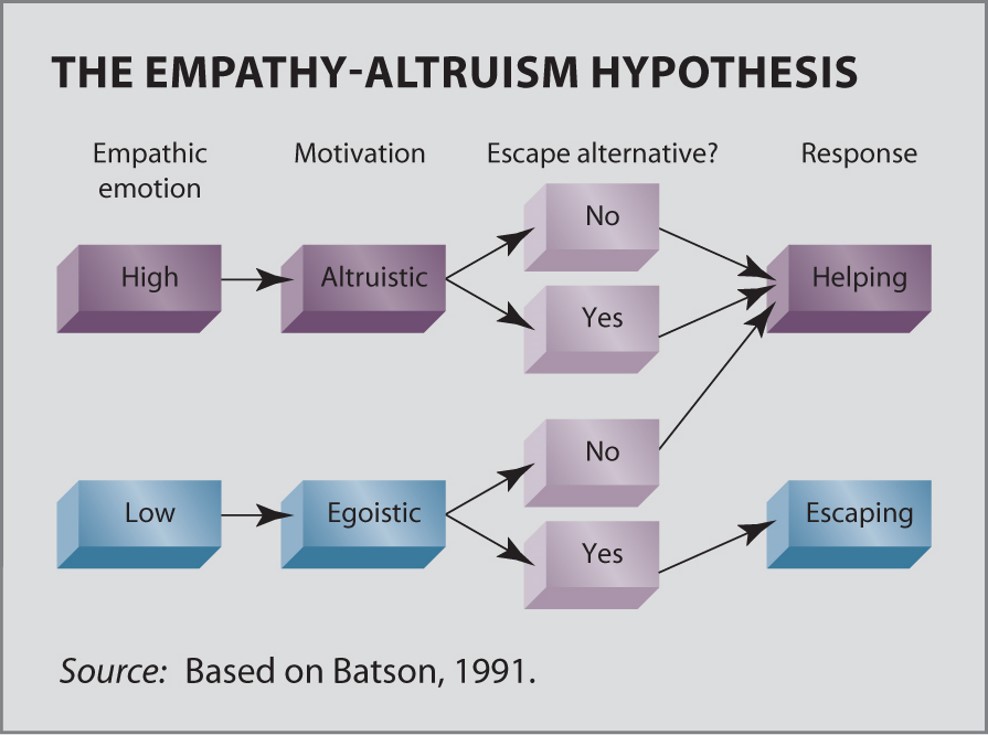
What were the results of the Elaine experiment?
Elaine experiment:
‘learning experiment': Elaine gets electric shocks (at random intervals), & real participants had to observe via a monitor
after a few shocks, Elaine tells about a traumatic experience in the past (fell from a horse onto an electric fence)
participant can help by taking Elaine’s place
2×2 design:
difficulty of escape: ‘you need to observe first 2 (easy) or all 10 (difficult) of the trials
similarity of Elaine: similar to Elaine (→ more empathy?) or dissimilar = indirect manipulation of empathic concern (based on surveys on personal values & interests before experiment)
When participants empathized with Elaine (similar): they helped her regardless of difficulty of escape
When participants did not empathize with Elaine (dissimilar): they helped more often when it was difficult to leave
→ Supports empathy-altruism hypothesis
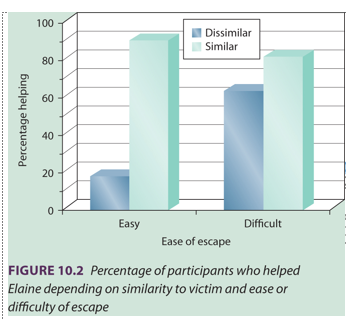
What’s the debate around the results of the Elaine experiment? What do review studies show?
Participants who empathized with Elaine also feel increased sadness, & it’s the sadness (not empathy) that predicts helping
Review study: consistent results & clear support for empathy-altruism hypothesis
→ In some cases (at least) altruistically motivated helping exists
Why don’t we help?
Bystander effect
Other contextual variables
time pressure
stress
location
cultural differences
What’s the bystander effect?
An increasing number of bystanders to an emergency reduces the likelihood that someone will help
What does the 5-step decision-making model (= process model) of bystander intervention entail? In other words, what makes some people help & others not, thinking of the context?
Noticing the event
high awareness vs low awareness due to stress, fuss
Emergency or not?
ambiguity (is this real?), pluralistic ignorance
Degree of personal responsibility?
vs shared responsibility
feeling of personal responsibility important to help
How can I help?
lack of competence
mode of assistance available or not?
Implementing help
audience inhibition
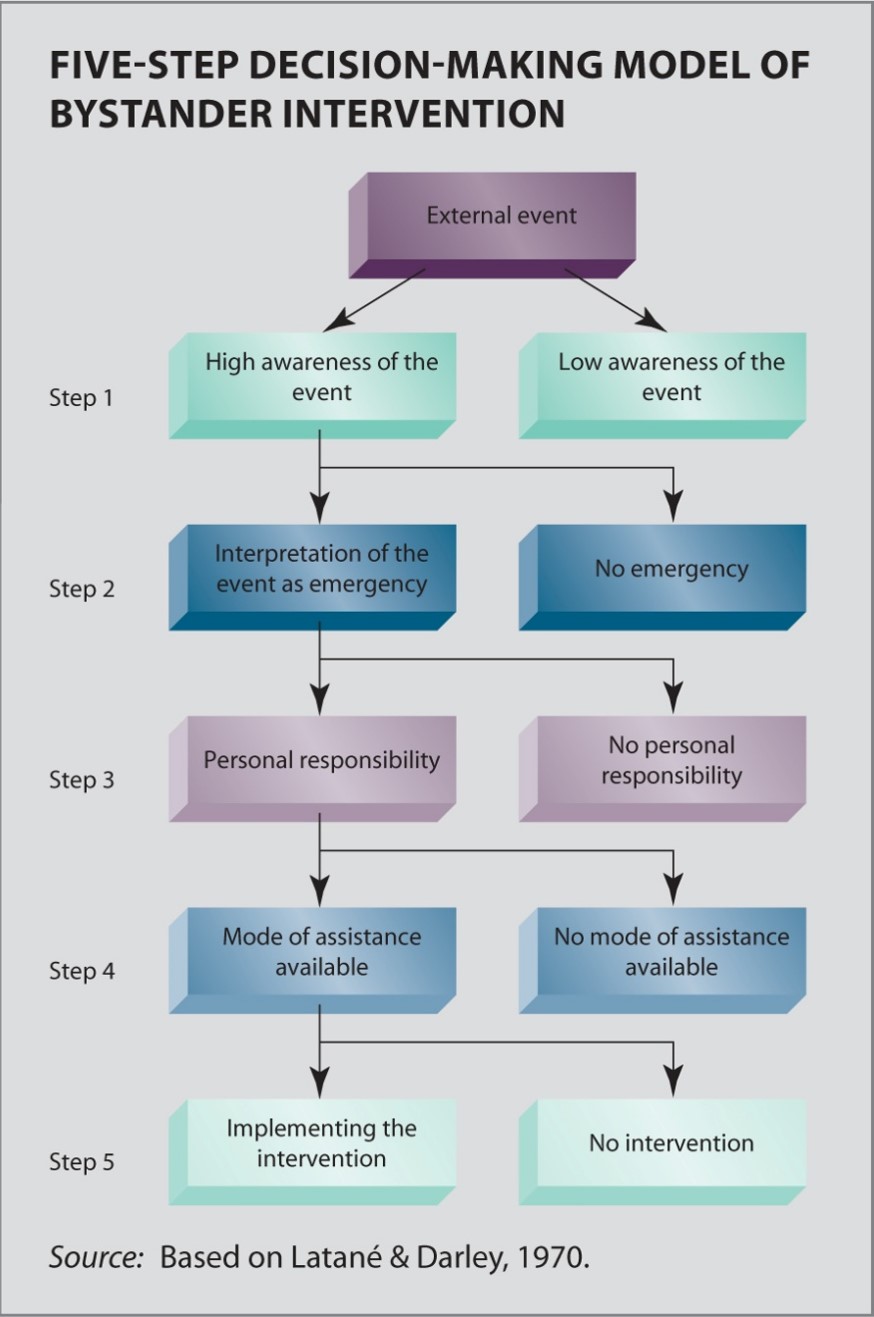
What are 3 inhibiting processes / explanations for the bystander effect? Tip: think of the steps in the process model.
Pluralistic ignorance
step 2: emergency or not?
Shared responsibility
step 3: degree of personal responsibility
Audience inhibition
step 5: implementing help
How does pluralistic ignorance (step 2: emergency or not) inhibit helping behaviour?
Because an emergency is unusual, we don’t know very well what is happening & what to do
People look at each other & become “models of inaction” for each other
if no one is doing anything, there’s probably nothing going on
How does shared responsibility (step 3: degree of personal responsibility) inhibit helping behaviour?
If you’re with other people, each individual bystander feels less responsible
If you’re the only witness, more likely to feel personal responsibility
How does audience inhibition (step 5: implementing help) inhibit helping behaviour?
In the presence of other people (”an audience”), we fear negative evaluation of our potential intervention & avoid possible embarrassment → decreases the likelihood of helping
What happens in the brain when there are more bystanders?
fMRI study: larger audience → less activation in brain areas responsible for (i) preparing action & (ii) mentalizing
mentalizing: seeing others as whole people with mental states, humanizing
less mentalizing → others become less human

What are 3 ways to overcome the bystander effect & how do they help?
Knowledge of the bystander effect
students who learned about the effect were more likely to help
bystander effect has declined over the years
Training to help in emergency situations
feeling of competence / high self-efficacy: presence of others may even facilitate helping when you feel competent to provide help
Person in need can also help
decrease ambiguity: make sure it’s clear that you are in need (cf. Step 1 & 2)
decrease shared responsibility by approaching specific individuals (cf. Step 3), ex. You with your green sweater, call an ambulance!
What other contextual variables prevent us from helping?
Time pressure
Stress
Location: countryside vs city
Cultural differences
How does the location (countryside vs city) prevent us from helping? What is the urban overload hypothesis?
People are more inclined to help in small villages (cf. reciprocity is more likely, less people around: related to bystander effect)
Urban overload hypothesis: people protect themselves from stimulus overload in big cities
How do cultural differences prevent us from helping?
Experiment: blind person needing help to cross the street in 23 countries
most help in Rio de Janeiro (Brazil) & San Jose (Costa Rica)
least in NY (USA) & Kuala Lumpur (Malaysia)
Wealth: inhabitants from wealthy cities less inclined to help
‘Simpatia countries’: caring for others important in Spanish & Latin American cultures
Why do we help? (4 reasons)
Cost & benefits of helping
Groups & identity
Social identity & bystander effect
Mood
What are the costs & benefits of helping according to the arousal cost-reward model? Tip: think of the subway train studies, in which a man collapsed in the subway.
No bystander effect at all
Arousal: cost-reward model
if it doesn’t cause arousal, you won’t help
= situational characteristics
Cost: loss of time, danger & effort
Reward: increased self-esteem, thanks from the victim, praise, honor & glory
Reward > cost of helping → people inclined to help

Aside from situational characteristics, the arousal cost-reward model distinguishes bystander from victim characteristics, what does each entail & what does this mean for helping behaviour?
Bystander characteristics
traits: competence, personal norms
states: mood, attention
Victim characteristics
similarity to helper: ‘we-ness’ increases arousal level & likelihood of helping
attribution of responsibility → empathy or irritation (see further)
Different processes can occur simultaneously
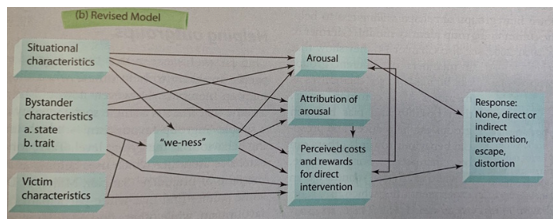
What’s the attribution-affect-action theory?
= Victim characteristics
Attribution of responsibility of victim
attribution of no control/responsibility (ex. blind victim) → empathy → helping
attribution of control/responsibility (ex. drunk victim) → irritation, anger → less helping
How do groups & identity stimulate helping behaviour? Related to this, what is ingroup favoritism?
We help the person who’s one of us (more empathy, similarity)
→ Ingroup favoritism: people more likely to help others when they’re seen as ingroup members
Why are we more inclined to help members of our own group (ingroup favoritism)? 2 reasons
Shared identity
common ingroup identity model: when members of different groups (Man U vs. Liverpool) are made to see themselves as members of a common group (football fans) → hostility decreases / prosocial behavior increases
study1: Man U-identity – helping Man U t-shirt
study2: football fan-identity – helping all football t-shirts (but not the “unbranded” shirts)
Social norms
most social identities contain norms to “look after your own”
some identities have norms that encourage helping outgroup members!
ex. religious identities, the rescue of Bulgarian Jews from concentration camps (WWII)
Which 2 strategies did the Bulgarian government us to prevent deportation of jews during WWII (they were the only country to not deport jews)?
Ingroup inclusion strategy
jews are Bulgarians → deporting jews = deporting Bulgarians
Ingroup norm strategy
deporting jews violates essential values of Bulgarian identity, it’d be very ‘unBulgarian’ to allow this
How do social identity relationships between different bystanders influence the willingness to help in an emergency situation? Tip: think of men vs women, alone vs together.
Experiment: watch video of emergency alone vs together
groups: all men/women or male/female majority
Men more inclined to help if they observed the emergency alone (or in a minority)
→ fear of negative evaluation by others?
Women more inclined to help if they observe the emergency together with other women (or in a majority)
→ fear of danger when intervening alone?
→ Social identity X group size
What kind of mood generates more help & what are some aspects that can cause this mood? What is this effect called?
Positive mood effect
sunny weather (→ more likely to fill in surveys, give tips…)
pleasant scents (chocolate, fresh bread…)
small gifts (cookie,…)
luck (‘finding’ money)
Why does a positive mood generate more help? (2 reasons)
People in a good mood want to maintain a good mood
More positive thoughts, ex. about the advantages of helping, positive thoughts about others, such as sympathy
How strong is the effect of a positive mood on generating help? Tip: is this effect found in the majority of people/contexts, over time?
Robust effect
even in young children
Short-term effect!
Can a negative mood also generate more help? Explain.
Yes,
sadness → more likely to help compared to neutral mood, to feel better
guilt → ‘good deeds compensate for bad deeds’
How strong is the effect of a negative mood on generating help?
Less robust & consistent compared to positive mood!
Strongly depends on situation & type of negative mood
Which issues did previous research have in terms of violence when studying prosocial behaviour?
Previous research neglected the role of violence in emergency situations
→ More help by group in a dangerous emergency situation (= bystander effect is attenuated)
What happens with the helping behaviour when it comes to rape (violence & helping)?
Field experiment: staged ‘attempted rape’
more bystanders help to stop/attack aggressor
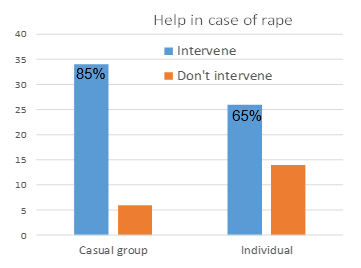
What happens with the helping behaviour when it comes to a shooting incident (violence & helping)?
Field experiment: simulation of shooting incident & emotional state of intense fear
over 6 years, 14 people tried to get help
unlikely to get ethical approval today!
What happens to the bystander effect when violence plays a role?
Bystander effect is less pronounced or does not occur in high-danger situations
What is a ‘reversed’ bystander effect & when does it occur?
‘Reversed’ bystander effect possible in dangerous emergency situations:
More bystanders in a dangerous emergency increased the likelihood that someone helped when
violent (villain) emergency situation (some form of crime, ex. theft)
aggressor is present
How does the sex of a person influence their helping behaviour when witnessing attacks?
Experiment: witness (simulated) attacks
male on female, male on male, female on male, female on female
degree of intervention? (attempts to stop the fight)
overall, female participants showed low intervention rates
How does the sex of a person influence their helping behaviour when preventing drunk driving?
Men & women intervene equally
How does the sex of a person influence their helping behaviour in general?
Men helped more than women in a range of studies
men: provide more heroic/risky help (often in emergency situation)
women: provide more communal & relational help (rare in emergency situation)
Any observed sex differences may be the product of the specific helping behaviors being studied! (witnessing attacks, preventing drunk driving…)
While some expressions of helping differ between sexes, men & women are more alike in their helping behavior than they are different
What are some long-term helping behaviours?
Donating blood, volunteering, charitable donation…
How are long-term helping behaviours sustained according to the social identity theory?
Identifying with a social role impacts long-term helping behaviour
ex. intention to donate blood depends on
others’ expectations
parents as model
personal norms
past behaviour
past receipt of help
role-identity as donor (is donating important part of who you are?)
How are long-term helping behaviours sustained according to the volunteer process model? Tip: think of antecedents, experiences & consequences.
Antecedents
personality
environmental factors
Volunteer experiences
volunteers become connected to each other & the people they volunteer for
Consequences
recruiting other volunteers
volunteering benefits well-being
young: + habits of social responsibility, less depression & problem behaviour
elderly: greater + mood, improved physical health & lower mortality rates
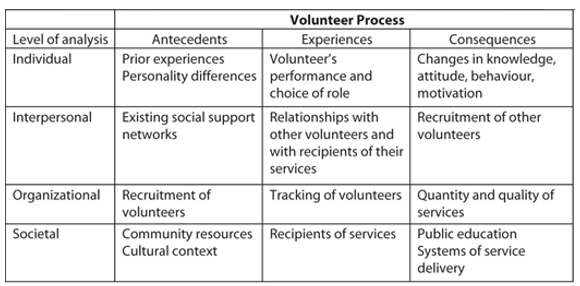
What kind of personality is a good antecedent for long-term helping?
Prosocial personality: ‘an enduring tendency to think about the welfare & rights of other people, to feel concern & empathy, & to act in a way that benefits them’
+ correlation with different forms of helping behaviour
How does evolution show that prosocial behaviour is a part of us?
Natural selection improves the chances of survival of individuals who help each other
cf. “the selfish gene” (Dawkins, 1989): We help others because of self-interest
What are the 3 principles of human altruism based on evolution?
Inclusive fitness
Reciprocal altruism
Strong reciprocity
What does inclusive fitness mean & what does this mean for helping behaviour (evolution)?
= ‘Kin selection’
Direct fitness: own reproductive success
Indirect fitness: reproductive success of relatives
→ More help towards genetic relatives in trouble
brother (50%) > nephew (25%) > cousin (12.5 %) > stranger (0%)
→ Coefficient of relatedness (↔ proportion of shared genes: humans share 99% of their genes; 98% genetic overlap with chimpanzees)
What does reciprocal altruism mean & what does this mean for helping behaviour (evolution)?
Expectation that a person you helped, will help you back later
only in intelligent, small groups in which members know each other
→ Sharing food in times of famine
Altruists are taking a risk, as their reward comes “somewhere in the future” & recipients can defect (“cheaters”)
What does strong reciprocity mean & what does this mean for helping behaviour (evolution)? Tip: think of the public goods game, cooperation & defection, punishment…
When helping is NOT self-interested
Human tendency to (a) cooperate with others & (b) punish those who defect, even when the punishment is personally costly & when there’s no expectation of receiving a reward for this sacrifice later
(b) = “altruistic punishment”: punishing selfish behavior in others (free riders), even when it’s costly to yourself
form of helping: it helps the group to remain cooperative
free riding → strong negative emotions (anger) → willingness to punish free riders
Which theory is used to explain not self-interested help & what does this theory entail?
Identity fusion theory
why do people make extreme sacrifices for their group?
self-sacrifice ↔ survival instinct/natural selection
‘Identity fusion’: when people develop deep sense of ‘oneness’ with a group → predicts self-sacrifice
personal & social identity are one, fuse together, ex. nationalistic people
strongly fused persons perceive other group members sharing core characteristics (values) → treated as ‘family like’ → worth dying for
ex. willingness to fight & die for their country, to commit suicide to save the lives of members of their country
The researchers who conducted to public goods game also took an fMRI scan of their participants. What happened in the brain during the different aspects of this game (altruistic behaviour, observing unfair behaviour)?
Altruistic behavior, helping others → striatum activated
reward-related brain area that’s also activated when receiving social or financial rewards
Observing unfair behaviour → bilateral insula activated
associated with negative emotional states (pain, hunger, distrust)
Football fans could offer or withhold help to ingroup or outgroup members that were suffering (electric shocks). What happened in their brains when they were willing & unwilling to help?
Willingness to help ingroup members → anterior insula activated
= (negative emotions but also) empathy-related brain area
Unwillingness to help outgroup members → nucleus accumbens activated
= pleasure-related brain area (in striatum), associated with deriving pleasure from the misfortune of others
We can conclude that helping is part of our DNA, but why don’t we always help (conclusion)?
Because there are contextual (# bystanders, time pressure, weather, parenting style, culture…) & personal (mood, prosocial personality, empathy, agreeableness…) variables that play an important role in predicting when people will be more inclined to help